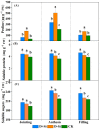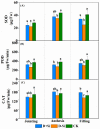The Effects of Foliar Supplementation of Silicon on Physiological and Biochemical Responses of Winter Wheat to Drought Stress during Different Growth Stages
- PMID: 37376009
- PMCID: PMC10304501
- DOI: 10.3390/plants12122386
The Effects of Foliar Supplementation of Silicon on Physiological and Biochemical Responses of Winter Wheat to Drought Stress during Different Growth Stages
Abstract
Drought is one of the major environmental stresses, resulting in serious yield reductions in wheat production. Silicon (Si) has been considered beneficial to enhancing wheat resistance to drought stress. However, few studies have explored the mediated effects of foliar supplementation of Si on drought stress imposed at different wheat growth stages. Therefore, a field experiment was carried out to investigate the effects of Si supplementation on the physiological and biochemical responses of wheat to drought stress imposed at the jointing (D-jointing), anthesis (D-anthesis) and filling (D-filling) stages. Our results showed that a moderate water deficit markedly decreased the dry matter accumulation, leaf relative water content (LRWC), photosynthetic rate (Pn), stomatal conductance (Sc), transpiration rate (Tr) and antioxidant activity [peroxidase (POD), superoxide dismutase (SOD) and catalase (CAT)]. On the contrary, it remarkably increased the content of osmolytes (proline, soluble sugar, soluble protein) and lipid peroxidation. The grain yields of D-jointing, D-anthesis and D-filling treatments were 9.59%, 13.9% and 18.9% lower, respectively, compared to the control treatment (CK). However, foliar supplementation of Si at the anthesis and filling stages significantly improved plant growth under drought stress due to the increased Si content. Consequently, the improvement in antioxidant activity and soluble sugar, and the reduction in the content of ROS, increased the LRWC, chlorophyll content, Pn, Sc and Tr, and ultimately boosted wheat yield by 5.71% and 8.9%, respectively, in comparison with the non-Si-treated plants subjected to water stress at the anthesis and filling stages. However, the mitigating effect of Si application was not significant at the jointing stage. It was concluded that foliar supplementation of Si, especially at the reproductive stage, was effective in alleviating drought-induced yield reduction.
Keywords: antioxidant defense; drought; photosynthesis; silicon; wheat.
Conflict of interest statement
The authors declare no conflict of interest.
Figures








References
-
- Xiao D.P., Tao F.L. Contributions of cultivars, management and climate change to winter wheat yield in the North China Plain in the past three decades. Eur. J. Agron. 2014;52:112–122. doi: 10.1016/j.eja.2013.09.020. - DOI
-
- Farooq M., Hussain M., Siddique K.H.M. Drought stress in wheat during flowering and grain-filling periods. Crit. Rev. Plant Sci. 2014;33:331–349. doi: 10.1080/07352689.2014.875291. - DOI
-
- Wang J.Y., Xiong Y.C., Li F.M., Siddique K.H.M., Turner N.C. Effects of drought stress on morphophysiological traits, biochemical characteristics, yield, and yield components in different ploidy wheat: A meta-analysis. Adv. Agron. 2017;143:139–173.
Grants and funding
LinkOut - more resources
Full Text Sources
Research Materials
Miscellaneous

